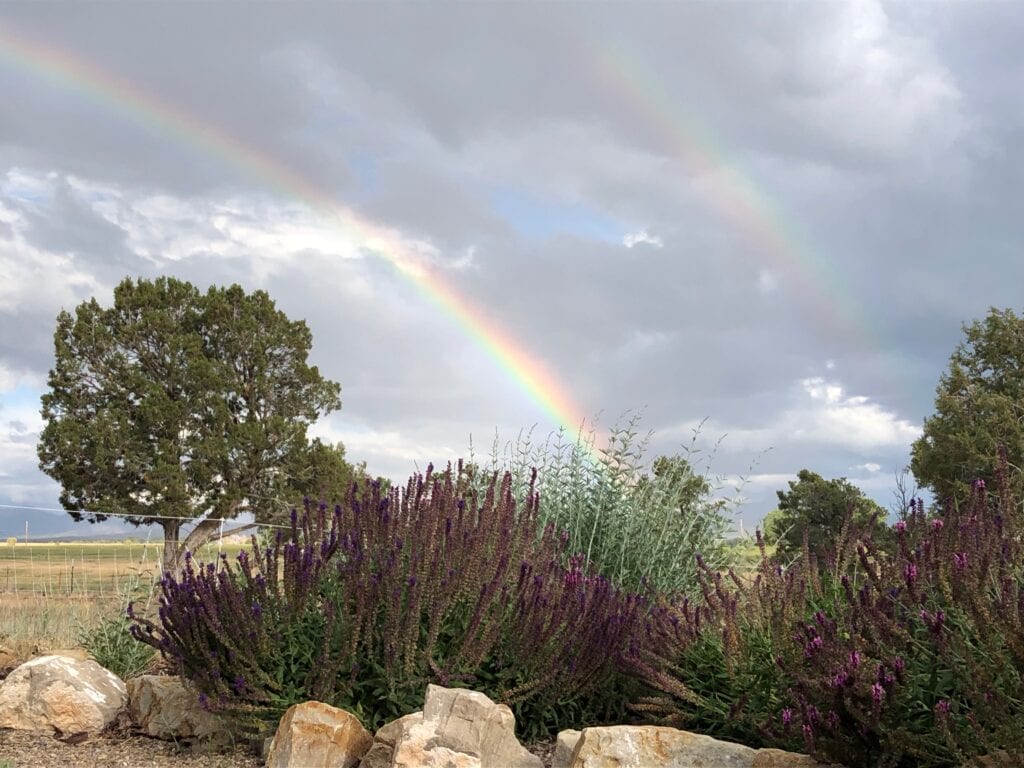Our most recent Post, entitled “It’s Time for a Reset” was widely mis-interpreted by readers as an announcement of our imminent retirement from farming. This could not be further from the truth. We are taking a year off, yes, from commercial livestock production. But there’s still a farm to run! The living farm organism requires constant attention and nurturing. We’re homesteading this summer, growing food mostly for ourselves, a little bit for the Fresh Food Hub, and enough to barter for other foods and services. Anne is gardening, albeit at a reduced size, with about 3/4 of the outdoor garden cultivated, and one of two hoop houses full of tomatoes, peppers, basil and eggplant.
The plan is to be back in full swing with our livestock production next growing season.
We have 140 broiler chickens on pasture to tend to, a flock of 50 laying hens, two pigs, 14 turkeys, two livestock guardian dogs, some ducks, a herd of goats and their babies, two horses, three barn cats, Vedder our precious red heeler and a mama cow and her calf. And there are water systems to manage, fence lines to keep charged and tight, soil amendment to build, a processing plant to keep maintained (and that will be used when the broilers and turkeys are old enough), a landscape of perennials, trees and shrubs to keep alive around the house, and weeds controlled. It’s never a dull moment at the farm as we’re constantly juggling chores and projects.
Meanwhile, in line with our reduced production schedule, we’re also not teaching apprentices this summer, the first time in nearly 20 years. This has allowed us to modify our daily schedule to fit our more immediate wants and needs. This has been a blessing. We’re able to complete chores early in the mornings, work on a project and then take advantage of the morning coolness to either go for a bike ride or a run.
As the day wears on, we turn to the real reasons we’re having a “Reset Year.” That is, we’re working on a long-term project to conserve this farm as an affordable place for future farmers to continue producing food. We’re also working on a drought contingency plan that tries to measure the appropriate scale of the farm given these dry times. Progress is being made on both of these fronts. Some form of a deed-restricted farm conservation easement is a fairly new concept in these parts. Fortunately, we’re working with the Montezuma Land Trust that have some experience in this regard. But the effort will require community involvement for it to proceed to accomplish our objectives. And we have to be patient in this process; it will take time.
As everyone knows, most of the Western US is gripped in a serious drought that is showing no signs of moderating. After a near-average winter’s snowpack, the runoff was virtually non-existent. Dry soils sopped up most of the snowmelt’s draining water. As a result, reservoirs and lakes in the region haven’t filled, and the ditch season was about 15% of average. Relative humidity levels during June’s heat wave were below 5% for days on end here in Norwood, drying out trees and grasslands, and sending us into repeated “Red Flag Warnings” for possible wildfires.
Fortunately, we’ve had some teaser monsoonal rains of late, for which we’re very grateful. And these initial storms did not arrive with a lot of lightning and thunder, so the wildfires have been avoided. For now. But rainstorms were not strong enough to drench parched soils and dry trees. We’re very anxious about the fact that almost 40 million Americans are now reliant on the Colorado River system for their domestic water needs. We don’t need to go into details about how low the water levels are at Lakes Powell and Mead, nor how low the flows are in river tributaries that feed the Colorado River. In fact, the Dolores River has gone dry below McPhee Reservoir. You read that right. It’s now a dry river until its confluence with the San Miguel. Not helping matters is that temperatures this summer have soared to record highs in this region.
Someone once told us, “If farming were easy, everyone would be doing it.” That thought runs through our minds on an almost daily basis.
This summer, we’re not only faced with the continuing drought and record high temperatures, but now, an infestation of grasshoppers unlike anything we’ve seen since about 2003. Of course, all these factors are related. The region has been in drought, ironically, since the day we started production 20 years ago. Temperatures have generally warmed, total rainfall during the summer monsoon has been dramatically less, winters end earlier and are not as severe, ground water has been depleted. A majority of climate scientists point to climate change as the culprit.
It’s fair to say that anyone living and working close to the land for their sustenance, has intimate knowledge of just how perilous and tentative our existence really is. The feeling of profound change is upon us. It is inescapable. We wake up to climate change on a daily basis.
These uncertain times point to the vital need for a continued focus and prioritization of securing local food sources, preserving local water and nurturing rich soils, to the best of our abilities for future generations. Where our food comes from should never be taken for granted.
But what’s the good news out of all this? In spite of all the challenges, food production at Indian Ridge Farm hasn’t stopped. We haven’t run out of water, we’ve been able to moderately contain the grasshoppers, the rich soils of the garden and one of the hoophouses are planted with nutrient-dense vegetables, the chickens are growing larger in the pasture and the turkeys are surviving on a diet rich in grasshoppers. Most importantly, we’re feeling calm. We’ll ride the wave where it takes us. We’re reminded, over and over again, that there is very little that we’re actually in control of. Mother Nature has her ways. We need to trust the process, the complexities, the mysteries; the fact that we don’t understand all the relationships embedded in the mosaic that makes up the living organism that is the farm.
Our mission hasn’t changed. We will continue to caretake this beautiful land and all its resources to the best of our abilities, creating a nurturing environment for bio-diversity to take hold, while maintaining the land for future generations.



The skies on Wrights Mesa as viewed from the farm NEVER disappoint and help keep things in perspective.
Tags:
